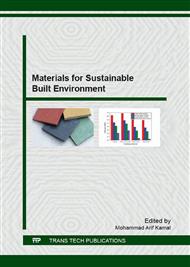p.1
p.9
p.17
p.27
p.38
p.45
p.54
p.66
Optimization of Construction Cost Using Industrial Wastes in Alternative Building Material for Walls
Abstract:
Building materials constitute about 60%-70% of the total cost of construction. Reduction in the use of conventional materials may not be possible; therefore, an alternative solution to use low cost materials would reduce the overall construction cost of a building. Industrial wastes, when recycled and reused as a building materials, not only aid in overcoming disposal problems, but also conserve natural resources, decrease energy use, and reduce pollution caused during manufacturing processes, and consequently reduce greenhouse gas emissions. Materials such as Copper slag, Phospogypsum and Fly ash, when used as supplements for sand and coarse aggregate in the manufacture of wall materials, reduce the cost of construction considerably. Additionally, construction of buildings using these materials leads to more energy efficient buildings and can gain additional weightage (points) in Green building certification. The aim of this paper is to highlight the cost reduction in using alternative wall material for construction, through detailed analysis in an apartment building in Chennai, Tamil Nadu, India. A comparative study between the different materials used such as, bricks, fly ash blocks and Alternative blocks made of industrial waste (Madhusudanan 2015)) were taken into consideration to assess the unit cost of each material. Similarly, a study of the cost performance between a load bearing structure and a framed structure was made, and it was found that the overall construction cost has a greater impact for a load bearing building when compared to a framed structure.
Info:
Periodical:
Pages:
1-8
Citation:
Online since:
May 2016
Authors:
Price:
Сopyright:
© 2016 Trans Tech Publications Ltd. All Rights Reserved
Share:
Citation:


